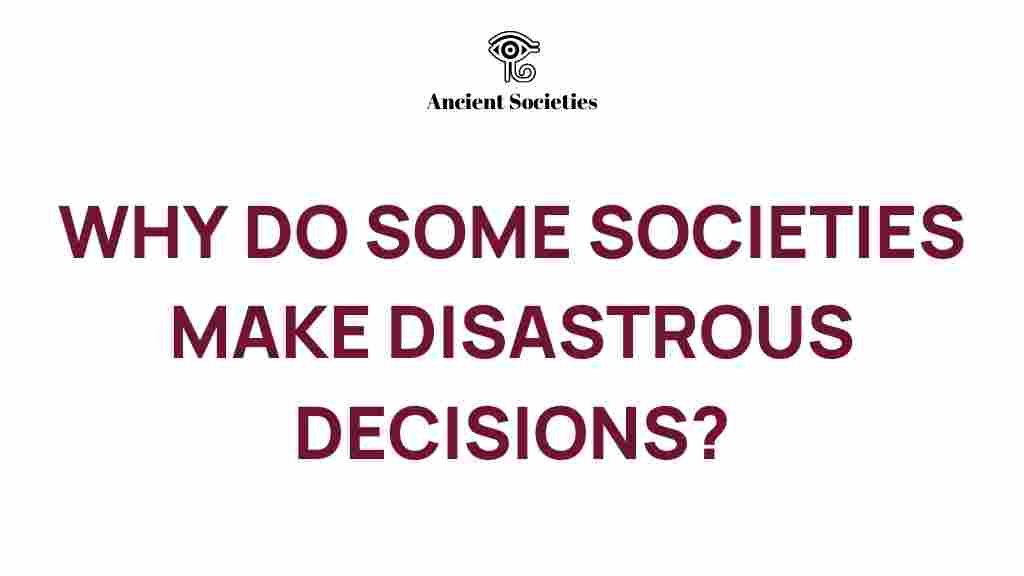Unraveling the Mystery: Why Do Societies Make Disastrous Decisions?
Throughout history, societies have made decisions that led to catastrophic outcomes. From economic crises to environmental disasters, the reasons behind these societal decisions often stem from a complex interplay of cognitive biases, cultural influences, and group dynamics. Understanding these factors can provide insights into how societies can improve their decision-making processes and avoid repeating past mistakes.
The Role of Cognitive Biases in Societal Decisions
Cognitive biases are systematic patterns of deviation from norm or rationality in judgment. They play a significant role in societal decision-making processes. Some of the most common biases include:
- Confirmation Bias: The tendency to search for, interpret, and remember information that confirms one’s preexisting beliefs.
- Groupthink: A psychological phenomenon where the desire for harmony in a group results in irrational or dysfunctional decision-making.
- Availability Heuristic: Overestimating the importance of information that is readily available, often leading to poor decision-making.
These biases can cloud judgment, leading societies to make decisions that may seem logical in the moment but are ultimately flawed. For example, during the 2008 financial crisis, many financial institutions exhibited confirmation bias by ignoring signs of impending collapse, focusing instead on data that supported their optimistic views.
Cultural Influences on Decision-Making
Cultural influences are another critical factor in societal decisions. Various cultures have distinct norms, values, and beliefs that shape how decisions are made. Some societies prioritize individualism, while others emphasize collectivism, which can lead to different decision-making outcomes.
For instance, in collectivist cultures, decisions may favor group consensus over individual opinion, potentially stifling innovation and critical thinking. In contrast, individualistic cultures may encourage more risk-taking, which can lead to both positive and negative outcomes.
Historical Analysis: Learning from the Past
Examining historical events can provide valuable lessons about societal decisions. A historical analysis reveals patterns in decision-making that can help us understand the consequences of certain choices. For example:
- The Great Depression: A failure of both economic policy and decision-making processes led to a global economic downturn.
- The Vietnam War: Poor decision-making, influenced by cognitive biases and political pressures, resulted in prolonged conflict and significant loss of life.
- The COVID-19 Pandemic: Initial decisions regarding public health responses were influenced by cognitive biases and cultural differences in risk perception.
By analyzing these events, we can identify common pitfalls in societal decisions and work toward more effective crisis management strategies.
Understanding Group Dynamics
Group dynamics play a crucial role in societal decision-making. The way groups interact can significantly influence the outcomes of their decisions. Important aspects of group dynamics include:
- Leadership: Effective leaders can guide groups toward sound decisions, while poor leadership can lead to disastrous outcomes.
- Communication: Open and honest communication fosters better decision-making, while poor communication can result in misunderstandings and conflict.
- Conflict Resolution: The ability to resolve disagreements within a group is vital for effective decision-making.
Understanding these dynamics helps societies create frameworks for better decision-making and crisis management.
Social Psychology and Its Impact on Decision-Making
Social psychology studies how individuals influence and are influenced by others. This field of study provides insights into how societal decisions are shaped:
- Social Proof: People often look to others when making decisions, which can lead to herd behavior and potentially disastrous consequences.
- Authority Bias: Individuals may blindly follow authority figures, even when their decisions are flawed.
- Fear of Missing Out (FOMO): This can drive individuals and societies to make impulsive decisions without fully considering the consequences.
By recognizing these influences, societies can work to mitigate their impact and enhance decision-making processes.
Step-by-Step Process for Better Decision-Making
To improve societal decisions, a structured approach can be implemented. Here’s a step-by-step process:
- Identify the Problem: Clearly define the issue at hand to ensure all involved understand the decision’s context.
- Gather Information: Collect data from multiple sources to gain a comprehensive understanding of the situation.
- Consider Alternatives: Explore various options before settling on a course of action.
- Evaluate the Consequences: Assess the potential outcomes of each alternative, considering both short-term and long-term effects.
- Make the Decision: Choose the best option based on the gathered information and evaluations.
- Implement the Decision: Execute the chosen course of action while ensuring effective communication and collaboration.
- Review the Decision: After implementation, assess the results to learn from the outcomes and improve future decision-making.
This structured approach can help mitigate cognitive biases and improve the overall quality of societal decisions.
Troubleshooting Common Decision-Making Pitfalls
Despite best efforts, pitfalls may still arise in societal decision-making. Here are some troubleshooting tips to address common issues:
- Addressing Groupthink: Encourage dissenting opinions and create an environment where individuals feel safe to voice concerns.
- Combating Confirmation Bias: Actively seek out information that challenges prevailing beliefs to create a more balanced perspective.
- Improving Communication: Foster open channels of communication among all stakeholders to ensure transparency and understanding.
By proactively addressing these issues, societies can enhance their decision-making processes and outcomes.
Conclusion: Moving Towards Better Societal Decisions
In conclusion, unraveling the mystery of why societies make disastrous decisions requires a deep understanding of cognitive biases, cultural influences, historical analysis, group dynamics, and social psychology. By recognizing these factors and implementing structured decision-making processes, societies can improve their crisis management strategies and avoid repeating the mistakes of the past.
As we move forward, it is crucial for societies to learn from history and embrace a more analytical approach to decision-making. This can create a more resilient future, equipped to handle the challenges that lie ahead. For further reading on enhancing decision-making processes, visit this resource.
By fostering a culture of critical thinking and open dialogue, we can work together to make informed, effective societal decisions that benefit everyone.
For more insights into decision-making, check out this academic article.
This article is in the category Society and created by AncientSocieties Team
